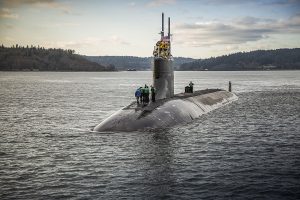It has been over a month since the nuclear-powered fast-attack submarine USS Connecticut struck an uncharted geological object in the South China Sea. The final investigation report came out in early November, leaving three USS Connecticut officials relieved of duty. This incident could have been avoided with “sound judgment, prudent decision-making and adherence to required procedures in navigation planning,” according to Vice Adm. Karl Thomas, commander of the U.S. 7th Fleet.
Despite all the suspicions, mostly from Beijing, with the release of the investigation report and the dismissals of the personnel concerned, this issue seems to have come to an end. However, the deeper worries behind the whole incident are hard to ignore. For example, have there been other unannounced collision in the South China Sea, and is there the potential for more in the future? Given the involvement of strategic offensive weapon systems like the nuclear-powered USS Connecticut, the potential for underwater accidents could turn the South China Sea into a fraught region of truly troubled waters.
The following four points are of particular concern.
First, there is the potential danger of nuclear leakage. The memory of the Chernobyl nuclear disaster is still fresh in our minds. Should a nuclear leak occur in the South China Sea from a nuclear-powered submarine, it will cause irreparable and huge damage to the marine environment of the region, seriously affecting the production and living activities of the countries around and nearby, casting an indelible shadow on regional peace and development.
Second, there is the risk of further intensification of the militarization in the South China Sea. The U.S. military’s decision to dispatch the USS Connecticut – a Seawolf-class nuclear-powered submarine – to the South China Sea in the first place is a typical move to intensify militarization in the region, indicating that the U.S. intends to maintain its one-way advantage in conducting reconnaissance against China in this region. Therefore, this reflects a strong Cold War mentality, which is extremely detrimental to regional peace, stability, and security.
Third, there is the long-standing dispute over how to define the right to freedom of navigation. In the Chinese view, it is unimaginable that the passage and entrance by foreign military vessels, fighter planes, and bombers near or even into a country’s territory or exclusive economic zone could be completely “innocent” and “harmless.” Thus, the right to freedom of navigation, in most cases, should naturally and essentially belong to civilian vessels. However, for a long time, the U.S. military has repeatedly used freedom of navigation as a pretext to create confusion by deliberately conflating the concept of freedom of navigation for civilian vessels with the convenience of its countless high-profile military operations. As a result, the definition of freedom of navigation insisted on by the U.S. is one of the concrete manifestations of its military hegemony in the global context, supported by its asymmetric military advantage.
Fourth, there is the question of transparency. There seems to be a self-contradiction in the U.S. military cruises in the South China Sea. If the United States was simply exercising the right to freedom of navigation as granted by UNCLOS (which the U.S. has not ratified), then why was the information about the submarine’s collision not released in a timely, open, and transparent manner? Instead, the news was made public only five days after the incident, after the submarine had sailed to Guam. A Chinese idiom from the Warring States period may best describe such situation: 师出无名 (shi chu wu ming), which means to dispatch troops without a righteous cause. For the sake of openness and transparency of military operations, the U.S. needs to give a definite account of the incident to the South China Sea neighborhood and the international community.
The timing of this event is also delicate. Not long ago, the United States and Britain signed an agreement with Australia to provide assistance to Australia as it seeks a nuclear submarine fleet, which probably will conduct cruises in the South China Sea in the future. Also, tensions across the Taiwan Strait are increasing, and Washington has made quite number of military and diplomatic moves to display its support to Taiwan.
If the temptation to maintain tensions in the South China Sea becomes increasingly irresistible due to geopolitical considerations driven by the Cold War mentality, it will be extremely important to maintain the necessary and timely communication of information. Although the intensified freedom of navigation operations (FONOPs) by U.S. planes and ships may not necessarily lead to direct military clashes, they do significantly lower the bar for unexpected encounters, confrontations, and even low-intensity conflicts. And who knows what may come after that?

































